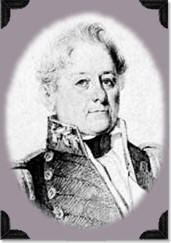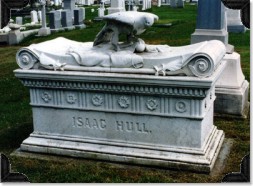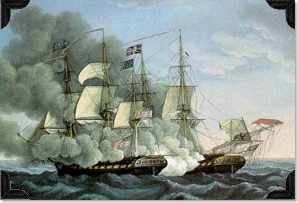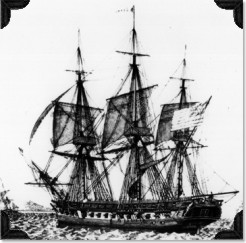
Isaac Hull (1773-1843)
Isaac Hull; born in Derby, Connecticut on 9 March 1773; began US Navy service as a cabin boy in 1787 and grew to become a very skilled seaman. In 1797, the Connecticut native had given up his ambition to be a seaman only to find his uncle, General William Hull, had secured a commission for him as 4th Lieutenant aboard the U.S.S.Constitution, and won distinction in the Quasi War with France when he captured a French privateer. Leaving the ship as a 1st Lieutenant in 1802, he received his first command, the U.S.S.Argus in 1803. Hull distinguished himself during the Tripolitan (or Barbary Coast) War, and provided support when American troops captured Derna (27 April 1805).
Thus, when the Constitution, with its tight fitting frame of Georgia live oak and its acre of canvas sails, next met the Guerriere, Hull did not fret. Instead, on 19 August 1812, near the Gulf of St. Lawrence, he held fire against the British and closed bows on, in order to present the smallest possible target, crying, "Not yet, sir, not yet," to his gunnery lieutenant. Captain James Dacres of the Guerriere shot distance charges that made not the smallest dent in Hull's ship. One of the 450 member Constitution crew then famously shouted, "Huzzah! Her sides are made of iron!"-- and the nickname "Old Ironsides" was born. Unfortunately for the enemy, the Guerriere was not made of iron. At last, when the ships drew close, Hull yelled, "Now, boys, pour it into them!" -- with such vigor that his breeches split. In his book The War of 1812, Theodore Roosevelt described what happened next: "By the time the ships were fairly abreast, at 0620, the Constitution shot away the Guerriere's mizzen mast, which fell over the starboard quarter, knocking a large hole in the counter, and bringing the ship round against her helm." The flag of the British ship was struck in surrender. The Guerriere was so crippled that prisoners had to be transferred and Hull had to burn her the next day, and return to Boston without his prize. The British losses in this battle were 23 dead and 56 wounded, while the Americans lost 7, with 7 wounded. Particularly due to the failures of the land battles, this victory for the young Navy gave a renewed sense of hope to the military. For the first time, a British frigate had surrendered to an American. Even those quite dissatisfied with the prospect of the war, much less how it was going, were quite impressed. In this half hour battle, the United States rose to the rank of a first class naval power, and Hull to the rank of Commodore and hero.
Hull was appointed commander of the fledgling Portsmouth Naval Shipyard, purchased in 1800. He found a weed infested island on the Kittery, Maine side of the Piscataqua River with only 13 workers. When he left two years later, over 300 workers were at work. Hull ordered construction of a massive wooden shiphouse in order to build the U.S.S.Washington indoors. This 74 gun warship, launched as the war with Britain ended in 1814, was the largest built in the United States to that date. The shiphouse was reportedly the largest wooden building in the world. Quarters A, that Hull ordered built for he and his wife Ann is still home to the current Navy Yard commander. In the mid 1850's, more than ten years after Hull's death, his ship Old Ironsides arrived in Portsmouth Harbor where it was fully rebuilt. Ironsides was assigned to Portsmouth as a receiving ship for nearly 20 years.
Commodore Hull's post war assignments were Commander of the Pacific Squadron, Commandant of the Washington Navy Yard, and Commander of the US Mediterranean Squadron. His last words before dying, 13 January 1843, were "I strike my flag". Commodore Isaac Hull was laid to rest in Laurel Hill Cemetery, Philadelphia, Pennsylvania


As Built1
44 gun frigate built at the Edmond Hartt Shipyard, Boston,
Massachusetts, in 1797.
Displacement: 2,200 Tons; Length: 175' 0"; Beam: 43' 6"; Draft: 16' 7"
OLD
IRONSIDES
By Oliver Wendell Holmes
16 September 1830
Ay, tear her tattered ensign down!
Long has it waved on high,
And many an eye has danced to see
That banner in the sky;
Beneath it rung the battle shout,
And burst the cannon's roar;
The meteor of the ocean air
Shall sweep the clouds no more.
Her deck, once red with heroes' blood,
Where knelt the vanquished foe,
When winds were hurrying o'er the flood,
And waves were white below,
No more shall feel the victor's tread,
Or know the conquered knee;
The harpies of the shore shall pluck
The eagle of the sea!
Oh, better that her shattered bulk
Should sink beneath the wave;
Her thunders shook the mighty deep,
And there should be her grave;
Nail to the mast her holy flag,
Set every threadbare sail,
And give her to the god of storms,
The lightning and the gale!

1 - These figures may vary depending on the account read.